Well this week has had time to review a book and attend a lecture on food and global warming and the experimental verification of anyon statistics and a few comments on flattening the curve.
First up, I finally opened up a very enjoyable little 150-page book, Before Time Began, by Helmut Satz. If you want to get a quick easy introduction to the big bang and the emerging universe and time, this is the book for you. Now, I have only read about the first 15-20 pages of the book, which is pretty normal for my reading style, usually because something else of interest comes along, but the book is an excellent discussion of how time began.
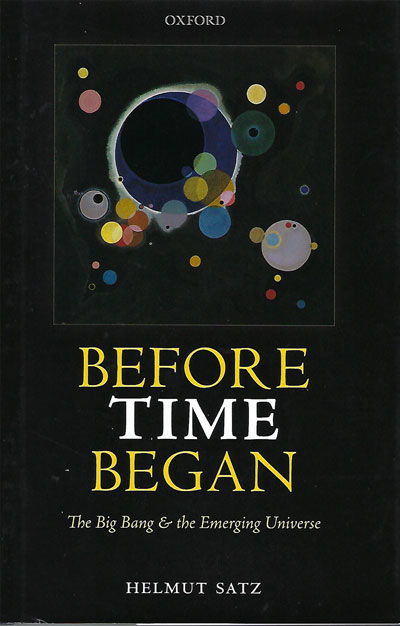 |
| Great little, 150-page discussion on the emerging universe (Source: H. Satz, "Before Time Began") |
The first interesting idea was about the formation of large galaxies from the collisions of smaller clouds of gas and dust. Have you ever wondered about why the final galaxy rotates? In this diagram from the book we see how two clouds of gas are pulled in the direction of each other by gravity, but the ultimate collision is not directly head on and the resulting collision will have some amount of rotation. Hmm, while it seems right for this one example, I guess for multiple numbers of mergers, you still end up with some residual rotation and the odds of just cancelling out the rotation is quite low?
 | |
|
The second interesting idea is how time might emerge from some initial starting conditions. Consider some initial starting condition of a pot of superheated water. The water is just ready to boil and the first bubble is just getting ready to burst out. Now the water is in a state where we can't really talk about a direction of time because even though individual molecules are moving all around there is no overall change and no force or reason to change at all. In one sense the situation is timeless. Now, when some random occurrence or fluctuation causes the first steam bubble to form and quickly expand and rise to the surface. Now we can see change and conditions are changing and we have a direction of time. If we play this movie backward we know what direction is the correct view of reality. So to me, this is a metaphor (or simile) of how time could have arisen in a featureless and unchanging initial condition where something could have been there before time began.
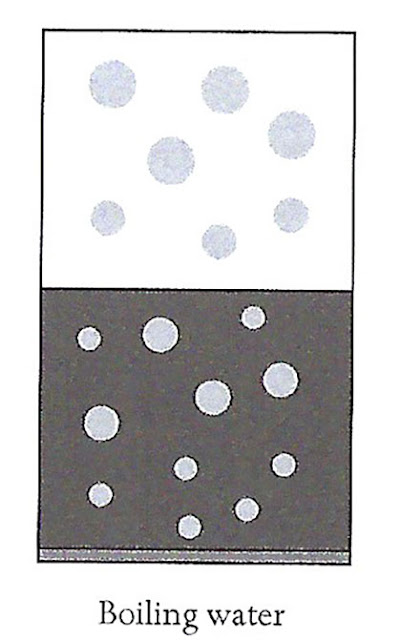 |
| Imagine one bubble in superheated water, expanding, as simile for big bang? (Source: H. Satz, "Before Time Began") |
Ok, so this is not a an actual argument about the possible initial conditions leading up to the big bang and it does show our usual view of time can be quite different. What I imagine in this is that before the big bang there could have been stuff around but if the conditions were so uniform that you could not identify any change, even though there was some random motion, then our usual concept of time would not have any meaning. Similarly for the end of time as the universe expands and cools and no change is possible at the heat death of the universe, just random motion.
I also wondered if this boiling water idea was a metaphor a simile for the big bang universe? Hmm, I might still have some books, somewhere, on writing and composition and style, but I can't find them. Years ago when I was working and writing technical proposals I would have reached out to Fantastic Editor, Now Moved to Nova Scotia, Charles, and asked him about it. But now I just had to settle for an internet search. What did I find? Yep, the boiling water scenario is a simile, not a metaphor, for the conditions before the big bang. Hmm, maybe this is enough review of English composition?
 |
| What is a simile and what is a metaphor? (Source: www.writersdigest.com) |
The Distinctive Voices lecture series has transitioned from live audiences at the Beckman Center to online audiences so people from the around the country can tune in and listen. This week the speaker was Amanda Little, Vanderbilt U., and her topic was "The Fate of Food."
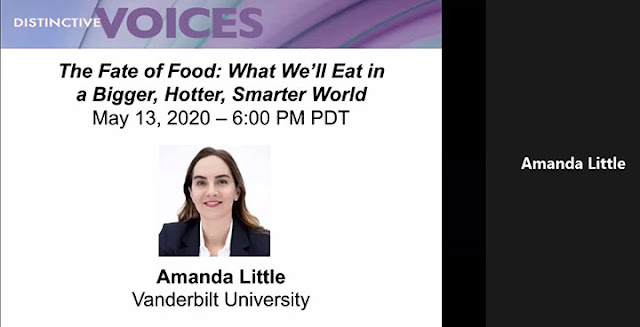 |
| Distinctive Voices lecture series now online (Source: NAS Distinctive Voices Lecture Series) |
Amanda has a new book out and she talks about the impact of climate change on food production. She was optimistic about how changing technology and different ways of growing and in some cases making food are being developed now.
 |
| Amanda Little talks about the fate of food with global warming (Source: Amanda Little, "The Fate of Food") |
Amanda talked about how the next limitation in the food supply might come from the lack of fresh water. Over 70% of the world's fresh water goes to agricultural uses. With growing populations and changes in climate the normal sources of fresh water might not be as readily available.
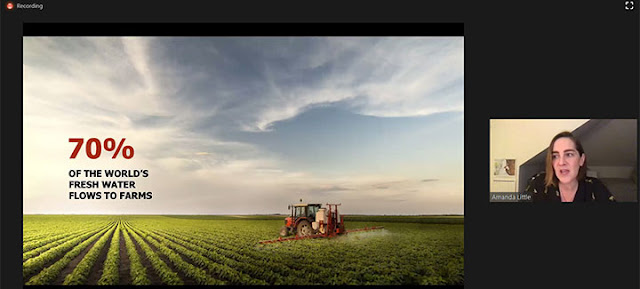 | |
|
She talked about how some researchers are developing advanced technology and automation based on artificial intelligence (AI) to improve agricultural yields while at the same time decreasing the amount of needed water and fertilizer and pesticides. She showed a large automated tractor that would go up and down the furrows and then identify when and where and how much each plant needed and then using something like printer technology would apply just the right amount at the right locations. You can see the pattern that was selected by the AI in the slide below. So pretty neat and thanks for that and we might want to check out your book, Amanda Little!
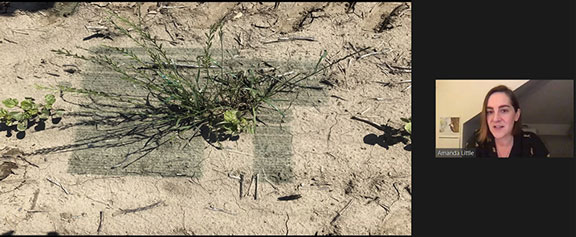 |
| Amanda Little shows how AI puts water and pesticides right where it is needed (Source: Amanda Little, "The Fate of Food") |
Another online lecture this time in a new discovery in physics was provided by Nobel Laureate Frank Wilczek. He gave an online lecture hosted by the Tsung-Dao Lee Institute (TDLI) in Shanghai. The lecture was at 8 pm in Shanghai, which was 5 am in Boston where Professor Wilczek was speaking, so those of us on the West coast had to be up and away at 5 am. Now as astronomer wannabes we are not too concerned about getting up at all hours of day or night, unlike many of our physicist wannabes who are sort of time wimps! Anyway, I managed to get up see most of the lecture on "Quanta of the Third Kind."
 |
| Nobel winner Frank Wilczek presents anyon lecture (Source: Frank Wilczek) |
Ok, so what is this talk about a third kind of quanta? Well, we normally just think of the universe consisting of just two kinds of particles or components, bosons and fermions. Each of these kinds has their own properties and statistics and bosons are said to have integer spin while fermions have spin values in 1/2 units. An example of bosons are photons which have spin equal to 1. An example of fermions are neutrons, protons, electrons, neutrinos, and quarks. So fermions are what most of the normal matter we see around us is made of.
Another property of bosons and their statistics is that they can all occupy the same quantum state while no fermions can be in the same quantum state. You can see in the slide below how bosons can all clump together without getting upset while the fermions have to arrange themselves in different energy states. We should remember that this third form of quanta does not invalidate anything about the well verified standard model of particles, which is physics in 3-dimension plus 1-D for time, while the new anyon discovered behavior is observed only in 2-D physical space with 1-D for time.
 |
| Bosons can be in the same state, while fermions can't (Source: Frank Wilczek at TDLI lecture) |
Wilczek and others first came to understand and to propose this third quanta almost 40 years ago. It was an interesting mathematical argument but at that time there was not experimental evidence for anyons. All of that started to change with the discovery of the fractional quantum superconducting effect. Now the timing of the Wilczek lecture is perfect in that experimental detection of anyon behavior has been found in 2-dimensional laboratory setups. The experiment and findings are in the April 10, 2020 issue of Science. So, finally after waiting 40 years, the data is finally coming in!
The experiments occur in 2-dimensional structures like films or like microprocessors fabricated in semiconductor processes. These layouts are very close to just 2-dimensional structures. It is something akin to Abbott's description of "Flatland" and the flat creatures can't understand how a 3-D creature can be outside of the circle in one instance and then inside the circle a little bit later. Anyway, the 2-dimensional structures constrain the functioning so that the anyon behavior can be observed and measured. I can't say I understand it, but it is pretty neat!
 |
| Fractional statistics in anyon collisions finally demonstrated (Source: Frank Wilczek at TDLI lecture) |
As part of my homework, because I don't really understand what an "anyon" is, was to find a simpler description for the anyon. This Quanta Magazine article explained how the topology of anyons begin to show up in 2-dimensions and not in 3-dimensions. You can see that in 2-dimensions, you can't shrink a loop further than the next door particle, but you can do it in 3-dimensions. This is why the experimental evidence for anyons is made in 2-dimensional substrates.
 |
| Anyon statistics and characteristics show up in 2-dimensions (Source: Quantamagazine) |
There is a whole branch of topology in mathematics that deals with the topology of braids. A braid, as in the long hair shown in the slide below, is stable because the hair cannot just pass each strand and become unbraided. Sorry, if you wanted more description of the topology of braids, you will have to look elsewhere because it is way beyond my understanding. But was we have seen in the experimental evidence, in 2-dimensions we can see the statistics of anyons, which is indeed the third kind of quanta!
 | |
|
Finally, it is hard not to dig a little deeper into the topic of epidemiology. Our entire lives are being constricted and a better understanding of why we in this lockdown mode of existing and we need to get a better understanding of the risks involved in opening up. My bias is to lean in the direction of exercising greater freedom, but it is important to understand the risks to us and from us to other individuals. Several posts in the past, starting with the March 20, 2020, post have had some comments about our amateur study of virology and epidemiology concepts.
One of the risk issues was how likely that we ourselves, though not outwardly showing any COVID-19 symptoms, could be an active spreader, like the stereotypical Typhoid Mary. Now, one article addresses that issue and it seems that the risk is not all that great, but there are still unknowns. This NPR article has some of the details:
https://www.npr.org/sections/goatsandsoda/2020/04/13/831883560/can-a-coronavirus-patient-who-isnt-showing-symptoms-infect-others
Another risk topic is how relevant is the strategy used in Sweden is to us here in this country or other countries in the world. When we see photos of Swedes living it up in cafes, while exercising some version of the social distancing protocols, it is hard not ask why can't we do that here too? My bias is to err on the side of freedom and not let fear overcome us and keep us all shutdown longer than necessary because we don't want the cure to be worse than the disease. Now many experts say that the Swedish approach just won't work here, but as a student of the topic I want to know what is the rational basis behind it and to understand the risk of adopting the strategy and the risk of not adopting the strategy. To that end, here is an article in Foreign Affairs magazine which proposes that the approach used in Sweden is a realistic model for use in the whole world. I can't tell, but I like the way it sounds so check it out for yourselves.
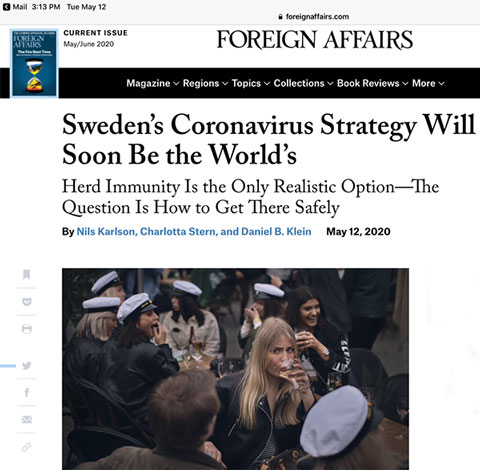 |
| Will Sweden's corona virus strategy be applicable worldwide? (Source: Karlson, et al, Foreign Affairs, 12 May 2020) |
On the separate topic of "flattening the curve" I found an explanation to the puzzling assertion heard before regarding that the number of affected patients is the same in each case, it is just that the health system is not overwhelmed. So in the diagram below you can compare the area under the two curves, which represents the number of people infected, and the assertion is that the number of infected people is the same, it is just that the rate of infection is spread out over time. At first, I didn't see why this would be the case, but when you look at the equations governing the growth rate if finally makes sense. So the use of precautions like social distancing just changes the short term impact on the health system, not the total number of people infected.
Be careful not to read into this mathematical result that we are just doomed. It is not the case at all, because we can take additional actions. First of all the social distancing precautions work to reduce the rate of infections and now the next step is to transition to more monitoring, tracking and testing to reduce the rate of infections much further and thereby actually reduce the total number of infections.
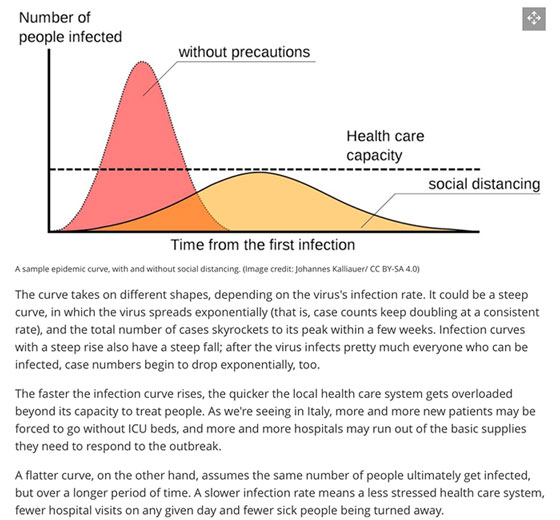 |
| Social distancing alone, flattens the curve, but doesn't cut number of infections (Source: www.livescience.com) |
Ok, that is enough serious stuff for the week. One of my recent acquaintances, David, always has an interesting take on how to adapt to our lockdown. Here, we see the recommendation about a treatment that might not affect the virus, but seems likely to help make the lockdown more bearable. Thanks for that David!
 |
| It might not be effective virus protection, but you don't mind the treatment (Source: D. Naiditch, Facebook post) |
Until next time, here from our burrow, stay safe, but it's time to recover more of our freedom,
Resident Astronomer George
Be sure to check out over 400 other blog posts on similar topics
If you are interested in things astronomical or in astrophysics and cosmology
Check out this blog at www.palmiaobservatory.com

No comments:
Post a Comment